
Clyde 2014
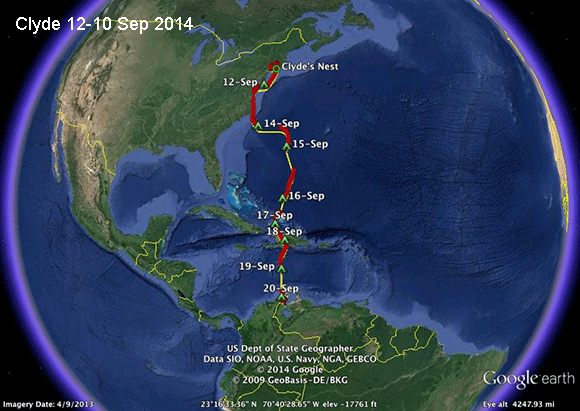 |
Clyde 10-20 Sep 2014Clyde has safely crossed both a corner of the Atlantic and the Caribbean. He was in South America 9 days after leaving Long Island. An impressive run for a young Osprey! Clyde is the first of our juveniles tagged in 2014 to make it across the Caribbean. Scroll down for more detailed maps to see, in chronological order, how Clyde got this far. |
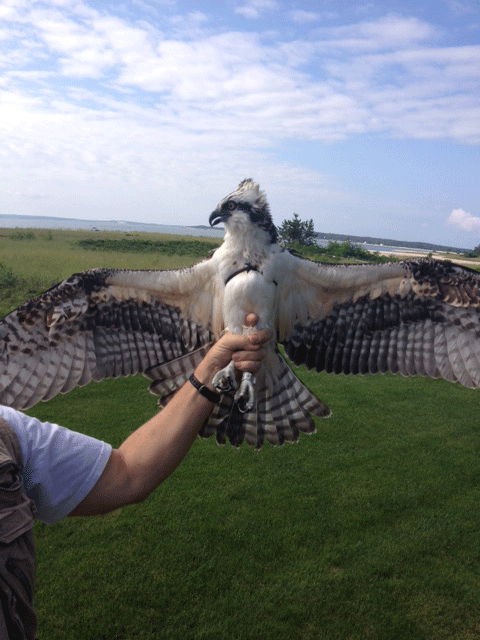 |
Clyde...... is a young male tagged on August 4th on the north shore of Peconic Bay in Southold, NY. His nest, out on Long Island's North Fork, is the same nest where we tagged Pearl last summer. When we set up to trap, he was off exploring somewhere. One of the neighboring youngsters made a pass over the nest, where we had our trap baited with a nice fresh porgy. The intruder was a bit skittish about landing the nest with the trap on it. Clyde came in after about 40 minutes and landed right on the trap and was caught quickly. We took him down for processing and left the fish in the nest. As we were outfitting him with his new transmitter, the young neighbor slipped in and snatched the porgy! Clyde weighed 1.26 kg, just under 3 lbs., pretty typical for a young male. Clyde's transmitter has been lucky for us, but not for the birds who have worn it. The first bird to carry it was Tucker. Tucker was the adult male at our other "old faithful" nest on the North Fork golf course. He was hit by a bus a month or so after we tagged him. Then we put the transmitter on Cutch, a young, non-breeding male caught while trying to pilfer our bait fish at the North Fork GC nest (I detect a theme here). Cutch made it to Colombia, only to impale himself on a submerged snag while trying to catch a fish. Bad luck for the birds, but good luck for us--the transmitter survived the crash with a bus, and it was pretty amazing to get the transmitter back from Colombia. Let's hope the luck changes for the birds. Third time's the charm? And our luck will stay good if Clyde lives a long life with the transmitter and we don't lay our hands on it for a long time. |
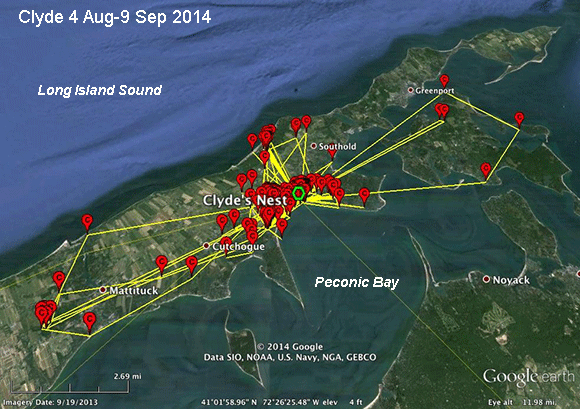 |
First movements: 4 Aug-9 Sep 2014Clyde spent the first month he was wearing a transmitter pretty close to home. He made a few forays east and west, up to 8 miles from his nest. |
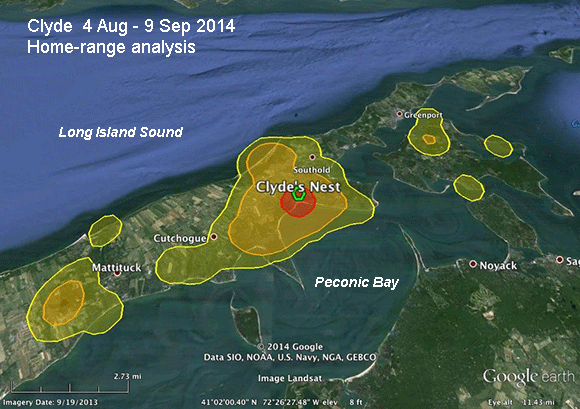 |
First movements: 4 Aug-9 Sep 2014This analysis shows where Clyde spent 50% of his time (the red area), 95% of his time (orange), and 98% of his time (yellow). |
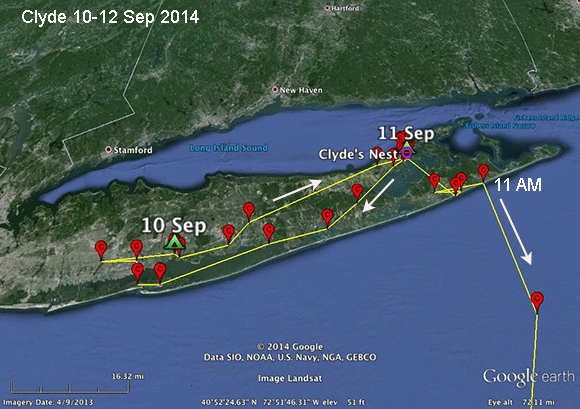 |
Migration begins: 10-12 Sep 2014It looks like Clyde was thinking about migrating on the 10th. He left home just before 8 AM and headed west to the mouth of Great South Bay. After a bit of zigging and zagging, he headed east for a while and settled down for the night near West Babylon. The next morning he returned to his natal area, where he spent the night. On the 12th he flew across Peconic Bay and was shortly on the south shore of the South Fork. Looks like he got cold feet again and milled around the shore. At 11, he finally screwed up his courage and took the plunge, heading south out over the open Atlantic with nothing but water on the horizon for as far as he could see. |
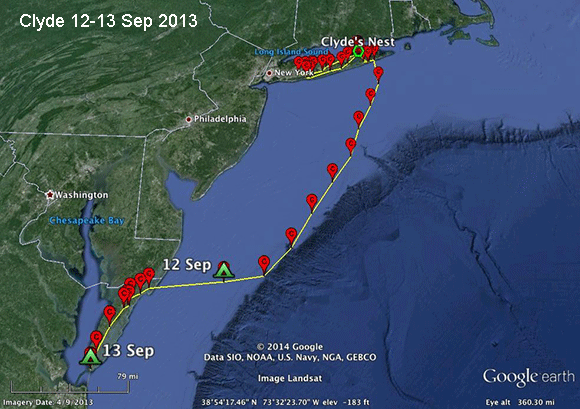 |
Migration begins for real: 12-13 Sep 2014After his apparently aborted first attempt to start his migration, Clyde got down to it in a big way on the 12th. He left Long Island's south shore behind him around 11 AM and headed out over the deep blue sea, bearing almost due south. That track would have taken him to the Bahamas, which would have been a long flight, but no longer than some of our Martha's Vineyard young have made as they, naively unaware that an Osprey can get to the Caribbean over land if you go west first, crossed the western Atlantic. Whether by some innate orientation or because of fortuitous wind drift, Clyde turned a bit west and flew parallel to the Jersey shore. Between 4 and 7 PM, he was averaging over 30 mph, which is fast for a migrating Osprey. Around 7 he turned west and headed for shore. He was about 50 miles east of the Delmarva (Delaware-Maryland-Virginia) peninsula shore at 8, so he probably made landfall on Chincoteague Island a bit before 10 PM. |
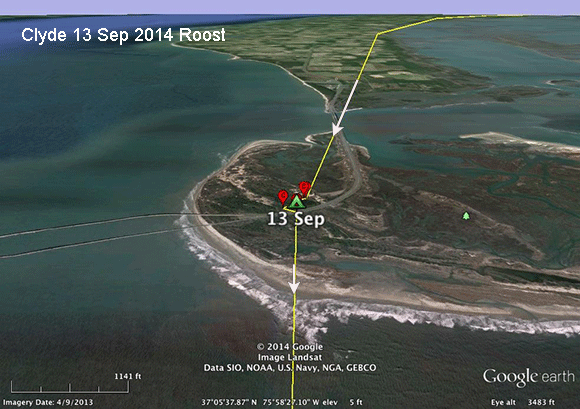 |
A roost at the tip of the Delmarva Peninsula: 13 Sep 2014Drivers of cars coming off the Delaware Bay Bridge-Tunnel early on the morning of the 13th might have seen Clyde, who spent the night on Fisherman's Island National Wildlife Refuge. It looks like he was out of there by around 6 AM, with some strong tail winds. He was making 30 mph by the time we got his first GPS fix later in the morning. |
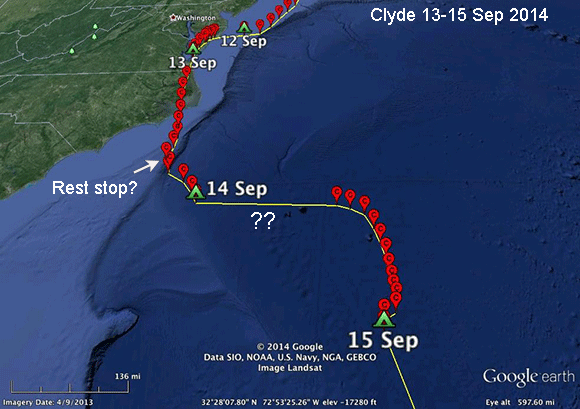 |
Back over the Atlantic: 13-15 SepClyde's compass doesn't seem to be working very well. After 10 hours almost due south on a track that would have taken him to Nassau, he probably got on a ship for a short rest. I don't know how else to explain an hour where he only moved 7 miles. After jumping ship (or some flotsom) he headed southeast for 3 hours before his GPS shut down. Then we don't know exactly where he went (hence the question marks), but we pick him up again 195 miles (313 km) due east at his 8 AM GPS fix. Justin Trabocco, a faithful follower of our Osprey maps, suggested that the eastern movement on the night of the 14th and early morning of the 15th is consistent with Clyde's having rested on a ship. This is a busy shipping lane and the speed is just right. It makes perfect sense and explains why his track makes the strange eastern shift. When his GPS came back up on the 15th, he was making a course correction to the south.
|
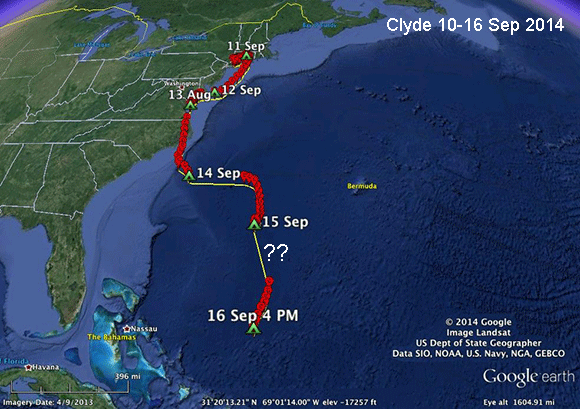 |
Cliffhanger: Clyde 10-16 Sep 2014Clyde is out over the Atlantic. Our last signal from him was at 4PM on the 16th At that point he had been over the Atlantic flying for 52 hours. It looks like he left Cape Charles around 6 AM (an unusually early start for a day's migration), flew over eastern North Carolina for four hours, and headed over the Atlantic around 11 AM. He was flying around 30 mph in the morning of the 14th, using some strong northerly winds to propel him along. Between 4 and 5 PM he only moved 7 miles, which suggests that he took a breather and rested on a ship or something floating. After that, it was non-stop through the 15th and 16th. On the 15th he changed his course from southeast to southwest, but during the night of the 15th-16th he drifted east again. When we pick him up on the 16th, he's changed course again back to a bit west of south. After our last GPS fix from him, he had about 210 miles to go before he'll make landfall somewhere in the southern Bahamas. So far he has flown about 1,100 miles (1,780 km) since he left his roost on Fisherman Island. The questions marks are just a reminder that we really don't know the exact route he took while he flew through the night when his GPS unit was turned off to save battery power. (The "13 Aug" point is obviously a typo--it was 13 Sep) |
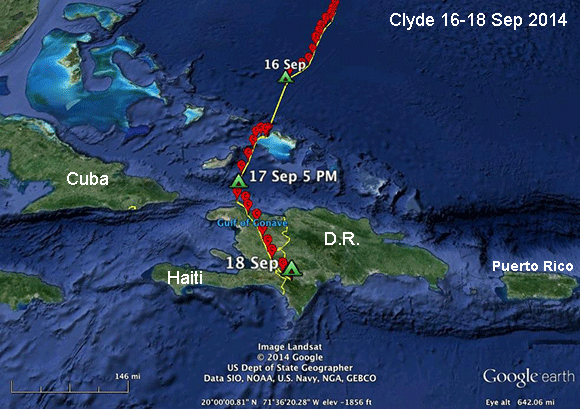 |
He made it!Clyde arrived on Turks and Caicos Islands around 1 PM on the morning of the 17th, 67 hours after leaving Fisherman Island in southern Virginia. He may have taken a brief rest on a boat on the first day of this leg of his migration, but it was virtually a non-stop trip, flying through 3 nights before finally getting to rest. 10 hours after landing at around 1 AM, Clyde was off again. Presumably he'd refueled with a fish breakfast. He started the next leg at 11 AM leaving Turks and Caicos behind around 1 PM. He arrived in Haiti around 6 PM. The next morning he was on the wing around 8 AM and made it into the D.R., flying right between Lago Azuei (where Belle always stops on the way north each spring) in Haiti and Lago Enriquillo in the D.R. He's heading straight for Cabo Beata, where almost all adult Ospreys leave for South America. Next step is the Caribbean, which should be a piece of cake after his trip across the Atlantic. We only have to worry about hurricanes now. Fall migration is high anxiety. |
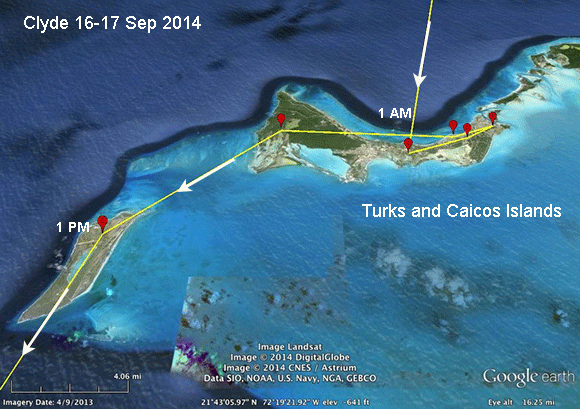 |
A few hours restClyde had a 10-hour break on the Turks and Caicos Islands. This would have been a whole new world, but fish are fish, and he presumably caught something to eat once the sun came up. |
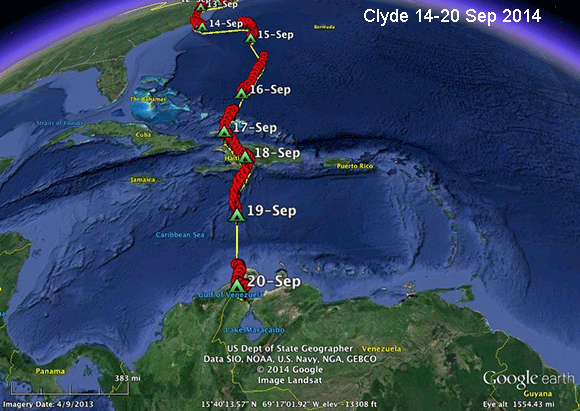 |
Safely across the CaribbeanClyde is the first of our newly tagged 2014 juvenile class to make it across the Caribbean. He left his roost in the Dominican Republic at around 9 AM on the morning of the 19th and left Cabo Beata--the southernmost point on Hispaniola--behind around noon. About 17 hours later, Clyde got to the Guajira Peninsula in northernmost Colombia. After a bit of a rest there, he moved on and spent the night of the 20th in Venezuela, just about where Lake Maracaibo feeds into the Gulf of Venezuela. |